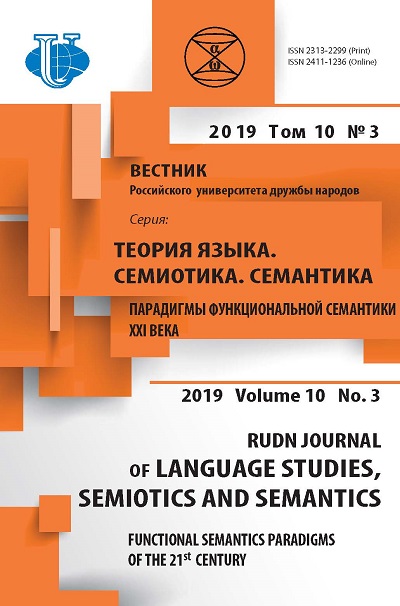What is the Colour of the Feeling (A Case Study of English Idioms with Colour Components)
- Authors: Pasechnik T.B1, Savelieva I.G1
-
Affiliations:
- State University of Humanities and Social Studies
- Issue: Vol 10, No 3 (2019): Functional Semantics Paradigms of the 21st century
- Pages: 714-721
- Section: CONCEPTUAL SPHERE AND AESTHETIC FUNCTION OF DRAMA TEXT AND DISCOURSE
- URL: https://journals.rudn.ru/semiotics-semantics/article/view/22128
- DOI: https://doi.org/10.22363/2313-2299-2019-10-3-714-721
Cite item
Full Text
Abstract
The present article explores English phraseological units with the meaning of emotion that have been fully or partially rethought and have a colour component. The emotive component of the idioms mentioned, is, thus, the object of the present study. In this paper we endeavor to show that the colour nominations which correlated to the concepts of ‘warmth’ and ‘coldness’ define the semantics of the whole idiom which is used for figurative naming human emotions. Looking at the use of colour components in an idiom, we cannot, but consider the key element of an idiom, i.e. idiomaticity, which we understand as the reinterpretation of an expression and the murkiness of its meaning. The article contains the analysis of both idioms which can be traced to free collocations and expressions which are not used in their literal meaning. The group of idioms in question primarily comprises the expressions of murky semantic structure. The examples of colour names exemplify the situation, when reinterpretation can apply no just to a single expression, but also to its components. In this case the colour component of the idiom acquires new semantics, i.e. It no longer means the colour in its literal sense, thus adding the meaning of ‘emotion’ to the semantic structure of the idiom, giving it a new meaning. It is worth pointing out that the number of colour nominations that can be viewed from this perspective is limited. At the same time a huge number of words denoting colours and shades have now emotive meanings whatsoever. However, if we look at other languages, we might find such examples, which in turn can be explained by the fact that people of different cultures perceive the world differently. Language is very good at capturing similarities and differences. The questions raised in the article are of utmost importance as they resonate with the current trends in linguistics, namely with the theory of secondary nomination in various languages and the issues of ideas’ verbalization in phraseological units. Typological and etymological studies of dozens of languages have revealed a set of universal mechanisms in the system of color naming. However, along with universal mechanisms, there are language and culture specific ones. The analysis of such kind gives us a better understanding of this part of the worldview in different cultures.
About the authors
Tatyana B Pasechnik
State University of Humanities and Social Studies
Author for correspondence.
Email: ptb.65@mail.ru
PhD in Philology, Associate Professor, Associate Professor of the Department of German and Roman Languages and Language Teaching Theory
Kolomna, RussiaInna G Savelieva
State University of Humanities and Social Studies
Email: savelieva.inna@gmail.com
PhD in Philology, Associate Professor of the Foreign Languages Department
Kolomna, RussiaReferences
- Wierzbicka, A. (1997). Language. Culture. Cognition. Moscow: Russkie slovari publ. (In Russ.).
- Frumkina, P.M. (1984). Colour, meaning, similarity. Moscow: Nauka publ. (In Russ.).
- Leont’ev, A.A. (2003). Basics of Psycholinguistics. Moscow: Smysl publ; St. Petersburg: Lan’ publ. (In Russ.).
- Frumkina, R.M. (2001). Psycholinguistics. Textbook for Students of Higher Education. Moscow: Akademija Publ. (In Russ.).
- Alefirenko, N.F. (2005). The Ambiguous Cases of Semantics. Moscow: Gnozis publ. (In Russ.)
- Vasilevich, A.P., Kuznecova, S.N. & Mishhenko, S.S. (2008) Colour and its Names in the Russian Language. Moscow: LKI publ. (In Russ.).
- Teliya, V.N. (1996). Russian Phraseology: Semantics, Pragmatics, Language and Culture Aspects. Moscow: Unity publ. (In Russ.).
- Teliya, V.N. (1981). Variations of Meaning in Language: Validity of Meanings. Moscow: Nauka publ. (In Russ.).
- Mironova, L.N. (2005). Colour Studies. Minsk: Vestnik publ. (In Russ.).
- Mironova, L.N. (1993). The Semantics of Colour in the Process of a Person’s Changing Psychological State. Colour Aspect in Psycology. Moscow: Nauka publ. (In Russ.).
- Timofeeva, A.M. (2003). Comparative Study of Colour Component of Worldview (Case study of idiolects of N. Zabolotskiy and R. Frost). Ural State University. (In Russ.).
- Language and Culture Studies: Theory vs. Empiricism. (2016). Moscow: Lenand publ. (In Russ.),
- Saveliev, S.V. & Savelieva, I.G. (2016). Ethnical and Cultural “Other” in Contemporary British Fiction: Going Beyond the Stereotype, International Research Journal, 10—3 (52), 83—88. (In Russ.)
- Phraseology In Krugosvet Encyclopedia (2007). Moscow. URL: http://www.krugosvet.ru/ articles (accessed: 12.10.2019).
- Crystal, D. (2007) Dictionary, Guide, Community and More. London. URL: http://www.AHWords.com (accessed: 12.10.2019).
- The Dictionary of Phrase and Fable. Classic Edition giving the Derivation, Source, or Origin of Common Phrases, Allusions and Words that have a Tale to Tell: dictionary Rev. by Cobham Brewer, E. (1978). New York: Avenel Printing.
- Kunin, A.V. (2006). English-Russian Phraseological Dictionary. Moscow: Russkij jazyk Media publ.
- Brewer’s Dictionary of Phrase and Fable. Centenary edition. Fifth impression (corrected). (1977). London: Cassell.
- Kunin, A.V. (1996). The English Language Phraseology. Dubna: Feniks publ. (In Russ.).













